|
Clan Carmichael International Gathering 2007
It was with great anticipation of seeing old friends
and family – cousins all – that we arrived for the welcome dinner in
the Carmichael Visitor Centre farmhouse kitchen restaurant on Tuesday
evening, June 26. Four of our number hadn’t arrived as they had
encountered bad weather in New York and were to be delayed until
Thursday. We were greeted by our Chief and his Lady. There were smiles
and hugs all around as we caught up on the news over pre-dinner drinks
in the courtyard. We met some Carmichaels we hadn’t previously known –
Wayne England from New Zealand and some of the Robinson family from
Toronto and Illinois.
We were served a delicious buffet dinner featuring
Carmichael meats prior to a welcoming speech by our Chief. He presented
a plaque to Ann and Jack Carmichael, half of which was the Carmichael
tartan and crest and half the Armstrong tartan and crest. Over 307
years ago, a Carmichael chief was murdered by an Armstrong as he did his
duties in the borders. Chief Richard said 307 years is a long time to
hold a grudge over anything; let bygones be bygones, he said. Ann was
an Armstrong before marrying a Carmichael. She and Jack have done much
for the Clan over the years and were honored for that service.
We then witnessed a Bond of Manrent ceremony in which
Steven Goeser from Utah, whose wife is a Carmichael from Australia, made
his pledge, ‘being of sound mind and able body, to take up arms and
fight for the Chief of Carmichael.’ He said he would ‘follow him into
battle wherever he may choose to go and always hereafter defend the
interests of Clan Carmichael.’ He swore allegiance to the Clan and
promised to wear the tartan and crest with pride. Richard then accepted
Steven as a Bond of Manrent member of Clan Carmichael and bestowed upon
him all the privileges of such Clanship. After a rousing cheer of ‘A
Carmichael, A Carmichael, A Carmichael,’ we were dismissed for the
evening, visited awhile, and then returned to our varying abodes for the
night.
The next morning we met at the Visitor Centre to
board a coach for a trip to the Kingdom of Fife and Loch Leven Castle,
the castle where Mary Queen of Scots and her four Maries were imprisoned
in 1567. It was here she signed her abdication papers on July 24,
1567. The castle ruins rest on a small island in the middle of the
Loch, the largest loch in lowland Scotland. We were ferried by small
boat, 12 at a time, to the island. There is evidence there was a
fortress on the island from the 5th century AD, but the
present ruins date from the 13th century, just before the
Scottish wars of independence. We wandered around the ruins, feeling
the cold air and thinking what it must have been like to be imprisoned
there with very little ground around the castle on which to walk, large
fireplaces trying to add some warmth to the thick stone walls on cold
winter days, and guards watching every move. There were no human
comforts that we could detect. We then ferried back to the mainland,
once again 12 at a time, to have lunch in the restaurant at the visitor
centre.
After lunch we boarded the coach once again and were
driven to the Edinburgh Botanical Gardens in search of the Aconitum
carmichaelii plants, discovered by William Carmichael McIntosh, a
professor of Natural History at the University of St. Andrews, from
1882-1917, and a founding member of the St. Andrews Temperance Society.
He became a famous botanist and marine biologist. The common name of
Aconitum Carmichaelii is Monkshood or Carmichael’s Monkshood, a
plant which is recommended for the back of a border because of its
‘imposing upright stems.’ Captain Dugald Carmichael, a Scottish
army officer and botanist who collected plants in New Zealand, has a
number of plants named after him including Carmichaelia, a New Zealand
broom.
We were met at the gates of the Botanical Gardens by
two guides, ladies who had not been told we were in search of our clan
plant, a carmichaelia. Looking a bit confused, they divided us into two
groups for their standard tour, so we were forced to search out the
plants on our own as they were telling us about other things! We
stalked along reading all the plant markers we could see, and suddenly!
an aconitum carmichaelii was spotted right in front of us
prompting us to interrupt the guide to point it out to everyone in the
group! It was not blooming, so we were unable to see its blue flowers,
but we photographed the plant anyway. The other group found two
carmichaelia plants. As we toured the gift shop at the close of our
tours, an aconitum carmichaelii was spotted for sale in the plant
section and was quickly bought to be presented to the Chief for planting
in his garden.
From the garden, we were driven along Princes Street
and around behind Edinburgh Castle to Prestonfield House at the foot of
Arthur’s Seat. Here we had time to tour the Prestonfield House Hotel
where rooms can be had for a mere £350 ($700) per night. This hotel is
said to be the most romantic in Scotland. Some of us thought if we
could splurge to afford the room, we surely couldn’t afford the food in
the beautiful dining rooms and would be forced to perhaps kill and eat
one of the peacocks wandering the grounds. Following our fantastical
musings, we adjourned to the former stables for our dinner and the Taste
of Scotland Show, a lively evening of song and dance which was enjoyed
by all. It was late when we arrived back at our cottage or hotel, but
we had a later start the next morning, so not to worry. We had had a
wonderful day with mostly sunshine and great fellowship.
It rained a great deal during the night and was still
drizzling the next morning. Our group day began at 11 a.m. when we met
at the Eagle Gates for a symbolic checking of the eagles. Claudia
LeMone has learned to play the bagpipes so piped us on our walk to the
Caput of Barony with Arthur Carmichael as the standard bearer. Chief
Richard gave us some of the history of the estate from in front of
Helton’s Tower while it rained. We then walked through wet grass and
mud to Kirkhill for more history with Mike Carmichael now as standard
bearer. The Chief and his family were joined by one of his younger
brothers, David, and his family for the scattering of the ashes of
Richard’s Aunt Peggy, sister of his mother. She attended previous
gatherings and encouraged him as he sought to become Chief back in
1980. It was a solemn occasion which concluded with Claudia piping
‘Amazing Grace’ before we marched back through soggy fields to the
marquee set up for lunch.
The blue and white marquee was decorated beautifully
for our lunch of sandwiches, choice of either ploughman’s pie or venison
and game pie, salads and desserts prepared by the lady who runs the
farmhouse restaurant. Hamish Carmichael attended the gathering for the
day and provided for sale a book which he has published on the
Carmichael connection in France. The rain continued and several cars
got stuck in the mud; another car had an encounter with part of the
forest as the back slid into a tree. We were wet and cold. The
veterans had arrived with waterproof hiking boots, but most of us had
wet feet all day, our shoes squishing with every step. After lunch,
some people gave up and returned to the hotel or their cottage, while a
handful of us stayed in the marquee to visit all afternoon. The sports
day had to be cancelled. The business meeting scheduled for 4 p.m. was
attended by a few of us. It continued to rain. The Chief erected a
small orange marquee over his barbecue grill so he could cook our meat
for the evening dinner before the ceilidh party. He was wearing an
orange sweater so seemed to disappear against the background of the
orange marquee. The floor of the main marquee was becoming a bit slick
in places as people came in and out with mud, water and grass on their
feet, so it was not advisable for anyone to dance at the party, but
smiles remained in place. John Carmichael, an entertainer for over 30
years in the Glasgow area, came to play music and tell a few stories
during the evening. Mike Carmichael was the emcee for the evening. The
talent displayed by family members varied from comedy to Carmichael
Jeopardy to singing and to playing musical instruments. The Chief and
his family, with Sarah on tin whistle, sang a song about a wild rover
that contained the chorus ‘No, nay, never, no more,’ which this reporter
has been singing constantly since that performance. David, the Chief’s
brother, who has a beautiful voice, sang a poignant song written by the
Armstrong, who killed the Carmichael, on the night before his execution
for the crime. We were all splashing our soggy way home around 11 p.m.
and praying for sunshine for the next day.
We did have a watery sun as we met at the Visitor
Centre on Friday morning to board the coach for our tour of the castles
of the Carmichael neighbors. The Carmichaels were granted their land by
the Douglas Chief shortly after the Battle of Bannockburn. This meant
the Carmichaels were no longer vassals of the Douglas’ but were men in
their own right. There is some speculation that the Carmichael had
saved the life of the Douglas Chief during that battle, but no one knows
for sure that was the reason for the granting of the land, although it
appears to be a sign of gratitude for something major.
We first went to Douglas where the factor of Douglas,
Jim Fleming, gave us a tour of the Douglas Museum then took us into St.
Bride’s Church where the Black Douglas’ are buried. We saw the tomb of
James ‘The Good’ Douglas, who was charged with taking the heart of
Robert the Bruce to the Holy Land on Crusade. On the way, he was killed
by Moors in Spain (he took the long route to the Holy Land apparently!),
so his heart was brought back to Douglas and Bruce’s heart was buried at
Melrose Abbey. From Douglas, we went to Hamilton, had lunch in the
Hamilton Visitor Centre then toured the Hamilton Mausoleum, built by the
10th Duke in 1852. (He appears to have been something of an
eccentric. He wanted to be buried inside an Egyptian sarcophagus which
was made for someone very short. In order to fit him inside, his legs
were cut off at the knees!) The inside of the mausoleum was used for
Masonic meetings and marble was imported from Italy to inlay the floors
with Masonic symbols. The great heavy carved doors originally on the
building are now lying covered at the side and can be viewed. By
slamming the present day doors, you can time the echo for 15 seconds.
This makes it difficult to hear anyone who is speaking as the echo goes
on and on. From the Masonic area, we went to the crypt below. The
bodies have long since been removed from the crypt as the ceiling
cracked in the movement of the building, and there was concern it might
come down, the mausoleum being built over an old mining area which has
settled over the years. However, the other side of the building
eventually sank too and the damage was prevented from getting any
worse. As we were walking back from the mausoleum to the coach, some
Spanish students spotted Jack Carmichael and Mark Nigro wearing kilts
and had to take pictures of them and with them for their souvenir
snapshots of their trip to Scotland! We continued on from Hamilton to
the ruins of Bothwell Castle, another Black Douglas stronghold built in
the 13th century. The oldest part of the castle, the
residential part known as the great donjon, was built for Walter de
Moray who became Lord of Bothwell in 1242. The 3rd Earl of
Douglas came into possession of the castle in 1362. There is a very
narrow and winding staircase in the donjon that has been fitted with a
rope handrail in recent years. We couldn’t help but wonder what it was
like to negotiate that staircase with no handrail and carrying a candle
in the early years of habitation.
The weather had held up for us this day, and we
returned to our dwellings to prepare for the closing dinner and Grand
Tartan Ball. Previously planned for the marquee in the Carmichael
walled garden, the event was moved to the Carmichael Village Hall so the
approach and the floor would be dry. A wonderful meal was provided,
again by the lady who runs the farmhouse kitchen at the Visitor Centre,
and a local group came in to entertain. Villagers, who do Scottish
dancing regularly, came to demonstrate the dances to us then to pull
people out of the crowd to participate. A good time was had by all even
if some of us have two left feet and will never get the rhythm of it.
Two local young ladies did Scottish dances for us; the music was
provided by drums, keyboard and accordion. A piper entertained and we
were given a demonstration of how the highlanders put on their plaid of
8 yards of tartan, pleating it, putting a belt below it and then lying
on it so they could fasten the belt and form the kilt part with the
extra yardage being slung over a shoulder or tucked into the top of the
belt to form a pocket for carrying items.
At the end of the evening, Chief Richard acknowledged
his staff, to whom we all showed our appreciation. They are a superb,
loyal small group of people with many talents. He acknowledged his
family, the Robinson family from Toronto and Napierville, Illinois, who
were a joy to meet. The children participated happily in all the
activities, whether the ceilidh or the dancing at the tartan ball.
Micky Carmichael and his family were acknowledged for their loyalty to
the Clan. Stephanie Nicholson and Jeanette Lemmon were recognized for
their contributions to the gathering for providing history and
background. The Chief said this was the ‘smallest, wettest and best’
gathering yet. The smallness provided an intimacy that is more
difficult to achieve with large groups; the weather brought us all
together in a cheerful common misery
J,
and it really was a most wonderful gathering. Three cheers for our
Chief – A Carmichael! A Carmichael! A Carmichael!
Jeanette Simpson Lemmon
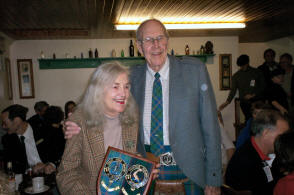
Jack and Ann Carmichael
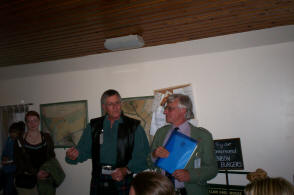
Bond of Manrent Ceremony
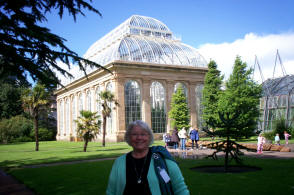
Edinburgh Botanical Gardens
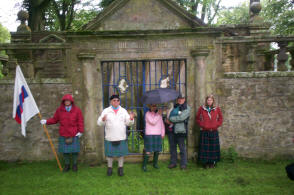
Kirkhill with Chief and family
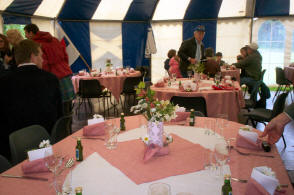
Marquee set up for lunch
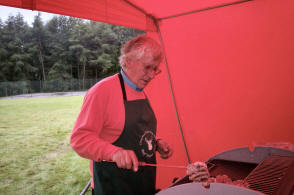
Chief barbecuing Carmichael meats for dinner
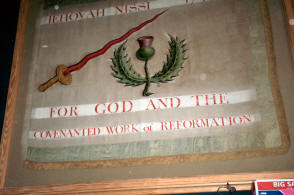
Flag in the Douglas Museum
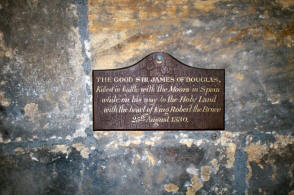
Black Douglas Mausoleum
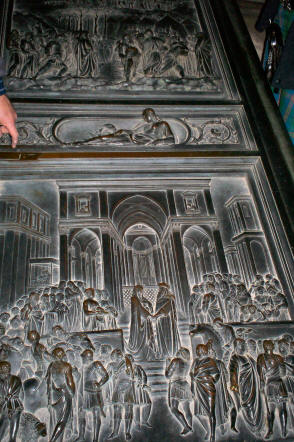
Heavy carved door at Hamilton Mausoleum
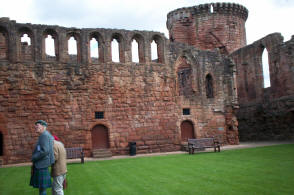
Bothwell Castle became a stronghold of the Black Douglases
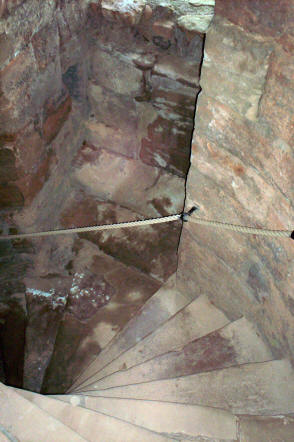
Narrow winding steps in living area of the castle
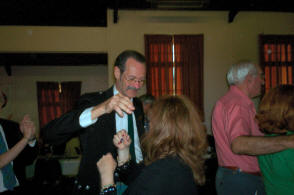
President of Clan Carmichael USA, John Carmichael, dancing at Grand
Tartan Ball
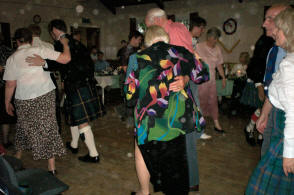
More dancing at the ball |

